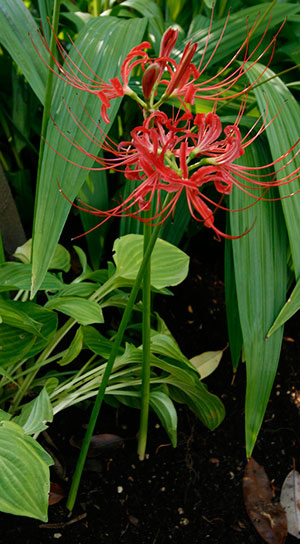Hurricane Lily

Late summer is the time that hurricane lilies begin popping up in Florida landscapes. Southerners have other common names for these almost magical flowers, including surprise lily, magic lily, resurrection lily, red spider lily, and naked lady.
What makes hurricane lilies interesting is that the flowers appear on their own, unfettered by foliage. The foliage appears in fall and persists through winter, dying back during summer’s heat. The flowers appear in late summer, usually after a heavy rain, hence the name “hurricane lily.”
Varieties
The most common hurricane lily in Florida is Lycoris radiata var. radiata, also known as red spider lily. The plant produces airy clusters of red flowers with whisker-like stamens on top of naked stems that will grow up to 18 inches tall.
Each bulb can produce one to four flower stems, and each cluster of flowers will last about two weeks if protected from wind and sun. The shape and color of the flowers makes them popular with butterflies.
Other related lily varieties for Florida:
- L. aurea, yellow spiderlily—yellow flowers
- L. alba and L. albiflora—pastel yellow, salmon or pink flowers
- L. squamigera, surprise lily—pink flowers (inconsistent blooming in Florida)
Planting and Care
Hurricane lilies can be grown successfully in North and Central Florida. They are often found growing on older homesteads throughout the Southeast and make great passalong plants. They are not always available through nurseries, though more internet nurseries are offering the bulbs for sale.
Plant hurricane lilies in late summer or early fall in a sunny or lightly shaded spot that has moist, well-drained soil. The bulbs can be planted directly in a lawn for striking effect when they bloom, or they can be planted en masse in beds.
Over time, the individual bulbs will grow into larger clumps that can be lifted and divided every several years to encourage flowering. Summer is the best time to divide clumps. However, be aware that recently divided or newly planted bulbs often won’t flower for at least a year, if not longer. Hurricane lilies, like many other types of garden lilies grown in Florida, contain various toxic alkaloids and can cause poisoning if consumed.
For more information on hurricane lilies, contact your local Extension office.
